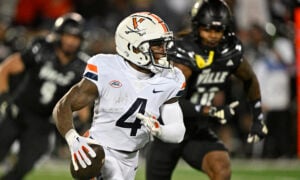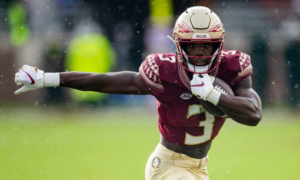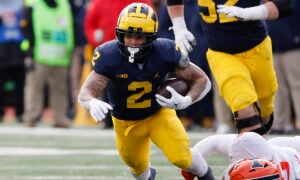Four Quarterbacks to Buy This Off-Season
We’re more than halfway through our trip around the fantasy-relevant positions. We’ve already looked at running backs to buy and sell, and we did the same with tight ends, peeping four to buy and sell.
Now we’re on to quarterbacks. In traditional one-quarterback leagues, signal-callers take a back seat to receivers and running backs, but quarterbacks are extremely important in superflex leagues, which are growing in popularity throughout the dynasty community. While some of these recommendations are not ideally suited for one-quarterback leagues, hopefully they’ll be useful for those in superflex formats or deeper one-quarterback leagues.
For clarity, all average draft position (ADP) info is pulled from our February 2018 ADP data, which includes incoming rookies. The ADP is for one-quarterback leagues, but it does serve as a good barometer for a quarterback’s ranking among his positional peers. To get a better feel for two-quarterback – and superflex – values, we’ll reference our two-quarterback rankings.
Ben Roethlisberger, QB PIT
Big Ben’s retirement chatter after the 2016 season was well-documented, and it understandably scared dynasty owners. Prior to that 2016 campaign, Roethlisberger was valued as the QB7, per our ADP. He finished as the QB8 by points per game that year, but his value slid down to the QB13 after his retirement talk.
[am4show have=’g1;’ guest_error=’sub_message’ user_error=’sub_message’ ]
Aided by the surge in solid young passers, Roethlisberger’s slide hasn’t stopped as he’s now the QB23 despite putting up more good numbers in 2017, finishing as the QB9 by points per game. Instead of speaking about retirement after this past season, Roethlisberger immediately said he was coming back for 2018, and he reportedly told teammates he wants to play three more seasons.
As he gets up there in age, Big Ben was destined to lose value. But his flirtation with retirement seems to have accelerated things, and even though nothing came of said flirtation, his value hasn’t rebounded since. While he’s proven we can’t fully take him at his word, Roethlisberger is a very good fantasy quarterback who doesn’t appear to be right on the cusp of hanging it up, and that is not reflected in his current value (QB23).
Roethlisberger is in the midst of a superb stretch. Going by points per game, here are Big Ben’s fantasy rankings in each of the last four seasons, starting with 2014 – QB5, QB9, QB8, and QB9.
Yes, Roethlisberger has some ugly home/road splits, but he’s also a proven fantasy producer who is surrounded by possibly the best supporting cast in the game, assuming Le’Veon Bell returns. On the heels of four straight top-10 finishes at his position, Roethlisberger is an ideal cheap trade target for those needing quarterback help in standard leagues, and he’s a great passer to pair with a younger quarterback. In that scenario, Big Ben allows you to get top-level numbers now while the young gun develops, and you also have the freedom to bench Roethlisberger in tough road matchups.
In two-quarterback formats, Big Ben’s value at his position (QB20) is roughly the same, and he’s the 67th overall player. If your superflex team is currently unsettled at quarterback, Roethlisberger is a cost-effective and proven way to patch up your situation.
Alex Smith, QB WAS
Valued similarly to Roethlisberger, Smith is the QB26 in standard formats and QB22 in two-quarterback leagues. He, too, is a nice target for those who need quarterback help but don’t want to spend big.
Smith has long been Mr. Checkdown, but he played like a new man in 2017. He led all quarterbacks in adjusted yards per attempt (8.6) and finished sixth in QBR (63.6), and he did that while continuing to be very judicious with the ball, posting a league-low 1.0 percent interception rate. It led to a hard-to-believe QB4 finish in fantasy as he topped Drew Brees by 3.4 fantasy points per game last season.
No one saw this coming.
Ironically, Smith’s two best seasons have resulted in him getting traded as the only time he’s ever sniffed numbers as good as his 2017 output was back in 2012, his last season with the 49ers.
Obviously, we shouldn’t be expecting Smith to all of the sudden be a guy who can be counted on to deliver top-10 quarterback numbers going forward. Maybe he can do it again at some point, but as we saw with Matt Ryan last year, when an established quarterback posts a career-best season, we should expect some regression. Also, I don’t know how the move to Washington will impact his fantasy output, but it seems like losing the big-play ability of Travis Kelce, Kareem Hunt, and Tyreek Hill would be a blow.
With all that said, Smith’s legs – 335 rushing yards in 2017, his fourth season in the past five years with at least 250 rushing yards – give him a decent weekly floor, and in one-quarterback leagues, you’re probably not relying on him to be an every-week starter if you trade for him. He is, however, a great option to pair with another cheap passer – say, someone like Blake Bortles or Philip Rivers – with the thought of playing matchups throughout the year.
In two-quarterback leagues, Smith is admittedly a scarier investment for two reasons. One, he’s ranked as the 75th overall player in that format, so he’s more expensive in terms of what type of non-quarterback player(s) you’d have to deal to get him. Secondly, he’ll likely be someone you’ll plan on starting every week as your QB2, so if regression hits him hard and he returns to the Smith of old, it’ll impact your lineup each week. But the Smith of old – someone who finished as the QB22 in 2016, QB21 in 2015 and QB23 in 2014 (going by points per game) – still has solid value as a low-end starter in superflex leagues, and with Washington signing him to an extension through 2022, one that includes $71 million guaranteed, Smith provides nice security as a QB2 option who should have a starting job for the next few seasons.
Mitchell Trubisky, QB CHI
Trubisky wasn’t good last year, but there are a few reasons to be optimistic.
One, he was a rookie, and most rookie quarterbacks don’t look good. Two, the Chicago Bears had one of the worst pass-catching groups in the NFL, with injuries to Kevin White and Cameron Meredith forcing Kendall Wright to serve as the team’s top wideout. (Wright was the only receiver with more than 46 targets, telling you how dire things were.) The Bears should get Meredith back, and even though we can’t count on White for anything, Chicago will likely address wideout in the draft and/or free agency.
Lastly, Trubisky showed some nice mobility, which is always a plus for a fantasy quarterback. Trubisky ran 41 times for 248 yards and two scores. I’m not sure if it was game-plan related or just random happenstance, but 150 of those rushing yards came in three games as Trubisky flashed decent fantasy upside in those outings. In all, he totaled four weeks of at least 14 fantasy points among his 12 starts – nothing to write home about, obviously, but if he can raise his floor by getting better as a passer, his legs give him an intriguing ceiling.
Of course, there’s no guarantee Trubisky takes a big step forward in 2018. After all, his stat line of a 59.4 percent completion percentage with seven touchdowns and seven picks doesn’t make you feel warm and fuzzy. But the Bears’ wideouts really can’t be worse moving forward, and the hiring of Matt Nagy as head coach should be viewed as a plus after Nagy was part of a Kansas City staff that helped the aforementioned Smith – a passer with some similarities to Trubisky in terms of the ability to throw on the move – put together a career year.
If Trubisky carried any sort of significant value right now, there’s no way I’d recommend buying him, because for all we know, he could be a total flop in the NFL. But he’s valued as the QB21 in standard formats, so the cost to roll the dice on him is pretty minimal. Trubisky is particularly appealing if you’re going with an aging quarterback – Tom Brady, Drew Brees and so on – as your every-week starter and can afford to stash Trubisky on the pine.
In two-quarterback leagues, it would be a real leap of faith to go into the season with Trubisky penciled in as your every-week QB2, but it could pay off in a big way if he does take a step forward this fall since he is fairly cheap right now (69th overall). The safer route to take would be playing matchups with Trubisky and another low-cost passer – someone like Andy Dalton or Ryan Tannehill (assuming he starts in Miami) – in your QB2 spot while deploying a reliable option as a QB1.
Tyrod Taylor, QB BUF
Taylor has been a cheap source of good quarterback numbers for the past three years. Starting with 2015, here are Taylor’s fantasy finishes among quarterbacks (going by points per game) since he took over as the Buffalo Bills’ starter: QB8, QB7, and QB19.
Taylor’s done it thanks to the fantasy cheat code that is a running quarterback. He’s averaged 35.7 rushing yards per game in his time in Buffalo – that’s basically a free 3.6 fantasy points per game (close to a passing touchdown in most formats). Despite his solid fantasy output, his value has remained low. After his QB8 season in 2015, he was valued as the QB21, and his second straight solid campaign didn’t do much to raise his stock as he was the QB18 in February of 2017. Now, with a lot of uncertainty surrounding his situation, Taylor’s value has cratered to the QB30.
The Bills have never been sold on Taylor, laughably benching him so Nathan Peterman could toss five first-half picks against the Los Angeles Chargers last fall, but the latest reports say Buffalo isn’t planning on cutting Taylor. Still, that doesn’t mean he’ll definitely be back in Buffalo in 2018 despite helping the team snap their postseason drought as the Bills’ coaching staff refused to discuss Taylor’s future at their end-of-year press conference. Taylor could be the Bills’ starter next season, and he could just as easily be cut or traded.
Kirk Cousins is the belle of the ball in free agency, but for teams who miss out on Cousins, Taylor could be a decent – and much cheaper – fall-back option. For fantasy purposes, Denver would be a dream spot for Taylor to land, even if he’s just a placeholder option under center, and they reportedly have some interest, but we’re probably wasting time trying to guess where Taylor could end up if he’s not in Buffalo.
The prevailing thought by most in the dynasty community must be that Taylor won’t land a starting gig in 2018 since he’s the QB30. I have no clue how things will play out, but going by the numbers, I have a hard time believing a quarterback who has ranked in the top 14 in Total QBR, per ESPN, in each of the past three years won’t be starting somewhere at some point in 2018.
For me, the bottom line is this: there aren’t a lot of good quarterbacks in the NFL, and Taylor has shown that he’s a serviceable option – better than serviceable if you go by QBR – so I don’t believe his days as a starting quarterback are over. Even if he doesn’t open the 2018 campaign as a team’s top quarterback, if he starts again in the near future, he’ll have fantasy appeal. Taylor has proven that he’s a good fantasy quarterback, and even though his numbers dropped a bit in 2017, he turned in at least 14 fantasy points in nine of his 15 games despite Buffalo’s ugly receiver situation.
In standard formats, Taylor may be on the waiver wire, and while I wouldn’t bend over backwards to get him, if you are weak at quarterback, he’s worth a flier. Taylor has more value, though, in superflex leagues as he is a dirt-cheap way to get access to someone who offers really good upside at a valuable position. I know it’s not fun – or easy to stomach – investing in a quarterback who isn’t guaranteed to be a starter in 2018, but it’s a risk I’m willing to take at his current cost.
[/am4show]
- Dynasty Capsule: Indianapolis Colts - January 17, 2019
- 2018 Summer Sleeper: Los Angeles Chargers - July 31, 2018
- Four Receivers to Sell this Off-Season - April 24, 2018


































































